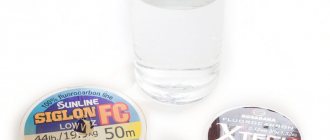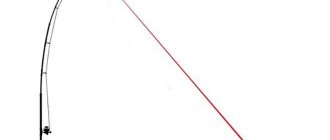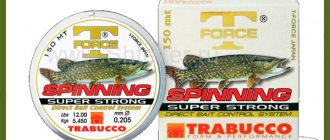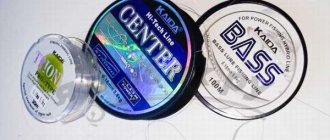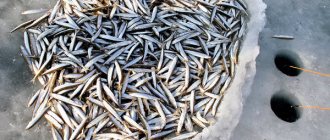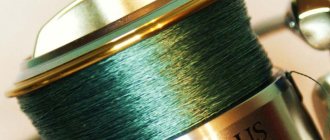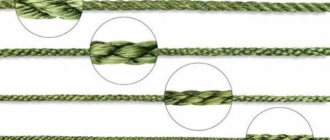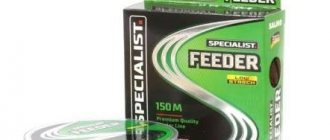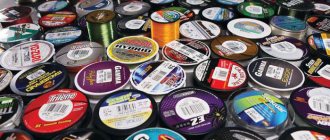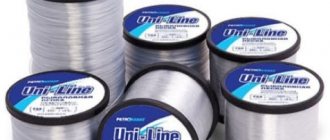Features of the fishing line
Fluorocarbon line is made from a polymer similar to Teflon. In appearance, it is very similar to monofilament and sometimes it is impossible to distinguish them. There are significant differences in quality between these fishing lines.
Fluorocarbon fishing line is much stiffer than monofilament, has low elongation, is almost invisible in water, has less memory, and sinks faster into water. For the same diameter, monofilament line is stronger than fluorocarbon line. All these features successfully allow fluorocarbon fishing line to be used as an excellent leader material.
And only in exceptional cases is fluorocarbon used as the main line. This happens when special attention is paid to camouflage of gear when fishing. They often use it when fishing by twitching, playing with a wobbler. In this case, the fishing line must be rigid, elastic and invisible.
When choosing a fishing line, two parameters are always taken into account: diameter and cost. The price of fluorocarbon fishing line with the same diameters is much higher than the price of monofilament, so it is rarely used as the main gear.
How to choose fluorocarbon fishing line
When choosing a fluorocarbon fishing line, the first thing you should pay attention to is the material from which it was made. The packaging should say something like Fluorocarbon 100%. This is a kind of quality guarantee from the manufacturer. The inscription “Fluorocarbon coated” on the packaging means that the fishing line is only coated with fluorocarbon, which means that after slight wear it will lose its strength. Even if the price of such a fishing line is small, you should not buy it, otherwise you will be disappointed.
Also pay attention to the inscription “Sinking” or “sinking”, this means that the fishing line sinks easily and freely in the water without additional effort. This is especially important when fishing with spinning rods.

Fluorocarbon coated - an example of low-quality fishing line
How to spot a fake
It is easy to distinguish real fluorocarbon from a fake: real fluorocarbon does not burn when ignited (for example, with a lighter) - it instantly curls up, forming black dry clumps at the end of the fishing line. Fake fluorocarbon (aka ordinary fishing line) burns when ignited, glowing with a small flame at the end, forming a plastic black clot when extinguished. This often happens with fishing line from Russian manufacturers. If you purchase fishing line directly from a store, check this way directly with the seller so that if anything happens you have the right to return the product immediately.
Pros and cons of the material
Fluorocarbon-coated line is used by fishermen mainly for leaders.
Advantages:
- hardly noticeable in water, the refractive index of fluorocarbon and water are close in value;
- high abrasion resistance: the material has a rigid structure and withstands deformation well;
- low memory: after tying knots, the fishing line quickly straightens out.
Flaws:
- insufficient tensile strength, you have to buy a thicker fishing line;
- knots must be knitted using a special technique;
- expensive, but the costs will be small due to the low consumption of material.
Good leader material
Fluorocarbon has become widespread as a leader material. It would be more accurate to say that having tried this material, most fishermen came to the conclusion: it makes no sense to use it as the main fishing line, and it is also expensive compared to monofilament. But just right for leashes. Less expensive than braid, inconspicuous and quite durable, fluorocarbon, even if it comes off, you can tie another leash. The main, expensive braid will be intact. Although such a leash is not an obstacle for a pike, it will still bite if it gets on the tooth.
Carbon fishing lines are used for leashes in spinning rods, float rods, fly fishing, feeders, and even for girders. But only 100% carbon. Monofilament with fluorocarbon coating for leashes is not suitable if you are catching predatory fish.
This line is stiffer, so the leashes get tangled less compared to a simple monofilament.
The fish does not see everything that is wound on the reel, but only the first 2 meters. By purchasing a reel and using fluorocarbon only on leashes, you will have enough for a long time.
It is better to tie baits to a fluorocarbon leader than to thin braid.
A fluorocarbon leader should have a weaker breaking load than the main braided line. Although this does not guarantee that the leash will break in the area where the hook is attached.
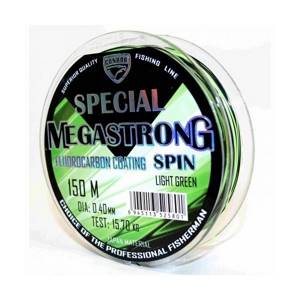
Fishing line "Megastrong"
How to make a leash?
To do this, you should take a minimum carabiner and 50 cm of fluorocarbon fishing line, which has the same strength as the main one.
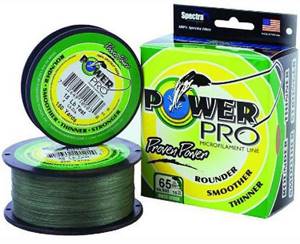
The fishing lines need to be tied with a reliable “Carrot” knot, and the carabiner must be tied using a “Grinner”. Before tightening the knots, it is advisable to moisten the fishing line with water to improve strength. The leash will be unnoticeable and will not scare off even cautious fish.
Node types
Fluorocarbon line, which must have a strong knot, undergoes a lot of weaving in the loops.
“Carrot” is often used to tie a leash to a braided line. To do this you need:
- tie the end of the leash with a regular knot, without tightening it completely;
- Pull the braid into the knot and make 10 turns forward, and then 6 back, pull the end of the fishing line into the same knot again. It is advisable to arrange the turns in a checkerboard pattern.
- Moisten the resulting knot with water and tighten tightly. Trim the ends of the fishing line above the knot, leaving 5–10 mm.
The result will be a strong and invisible knot in the water.
"Albright" is used when there is a large difference in the thickness of the tied lines. Connecting fluorocarbon fishing line with braided line is not difficult:
- fold the fluorocarbon fishing line in half, making a loop;
- pull the second line into the loop and, stepping back a little, make seven turns around the loop;
- pull the end of a thin fishing line through the loop;
- Tighten the knot and trim the ends.
The diameter of one line can be no more than 3 times larger than the diameter of the other.
“Grinner” - this type of knot is considered universal. They can be used to tie a swivel and monofilament or fluorocarbon fishing line:
- pull the fishing line into the swivel ring at least 15 cm;
- thread the end of the fishing line from above into the ring again so that a small loop is formed;
- with the remaining end up from the ring, make at least 5 turns around the loop;
- thread the end into the loop and tighten, trim off the rest.
"Rapala" is a strong knot that connects fluorocarbon fishing line to the hook:
- tie a loose loop, departing 10 cm from the end of the fishing line;
- thread the end of the fishing line into the ring of the swivel, and then pull it through the loop and make three turns around the fishing line;
- the end is turned, leaving a large loop, and pulled first through the first and then through the large loop;
- tighten and cut.
When tying different types of knots, you must ensure that the swivel has a smooth ring. Any uneven surface of the ring can ruin the fishing line and reduce its service life. Before tightening the knot, moisten the fishing line with water, its friction will decrease.

Beginning fishing enthusiasts should try tying them on a simple rope or cord before tying knots on an expensive fishing line.
Myth 2 Fluorocarbon is not visible underwater.
Manufacturers claim that fluorocarbon is invisible under water, especially compared to monofilament, unfortunately this statement is quite difficult to prove or disprove, we do not know how fish see.
From various tests of these lines, there is little or no difference in visibility between nylon lines and fluorocarbon lines.
Refractive index:
- Water - 1,333.
- Fluorcarbon - 1.42.
- Nylon monofilament - range from 1.53 to 1.62.
As you can see, the difference in numbers is not big. Again, we should not forget that any fishing line, when lowered into the water, will create various vibrations and vibrations, which the fish perfectly feels with its lateral line, and the larger the diameter of the fishing line, the stronger these vibrations will be, so any fishing line under water will be noticeable to the fish.
This explains that the worse the bite in a pond, it is most effective to use a fishing line with small diameters, up to 0.08 mm, this reduces the vibrations of the fishing line in the water, and the fish are less afraid.
Here are the results of our test:
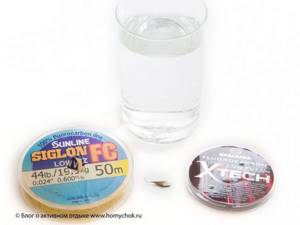
Breadboard for testing We recommend: Braided line VS monofilament
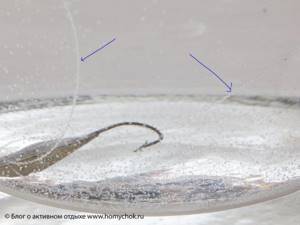
The photo clearly shows both types of fishing line; in the summer we will definitely conduct a test in a natural body of water, underwater, lowering the camera under water.
Sunline line
High-quality fishing line is the key to a rich catch. Fishermen always place high demands on this equipment. Sunline fluorocarbon fishing line is the undisputed leader in the global market . The line has increased rigidity and maximum wear resistance. There is a wide range of diameters on sale, allowing you to choose fluorocarbon for fishing wary fish and predators with sharp teeth.

Sunline line is suitable for a leader when fishing in places where the bottom is covered with stones, snags and shells. It holds popular knots well. The manufacturer produces fishing line in spools of 30 and 50 meters, so for the price of one skein of 100 meters, a fisherman can purchase 2-3 skeins of different diameters.
Advantages of Sunline fishing line:
- excellent quality at an affordable price - the cost of the same products from other brands is much higher, but the quality is lower;
- significant specific gravity, the line sinks well;
- increased abrasion resistance, low stretch coefficient;
- A large set of models can be selected for any type of fishing.
Using fluorocarbon line when fishing for trout with micro-oscillators
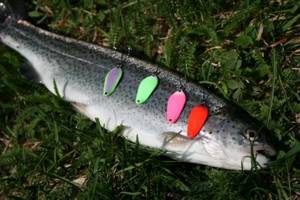
Experienced fishermen, when going long-distance fishing in the light and ultralight classes, use braided line. Of course, Fluorocarbon fishing line also has positive reviews for this type of fishing. For example, if the water is still and you are fishing with micro bait, this material will sink along with the bait, although the braid will float on the surface. This means that this line can be used to immerse the bait to greater depths.
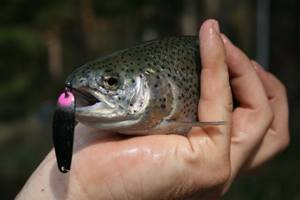
When fishing for trout with micro-spinners on paid reservoirs, it is better to use fluorocarbon. It is known that trout are caught on light spoons, the mass of which is 0.6-1.8 g, and it is important to ensure uniform movement at a minimum speed; the movement of the bait should be ensured in a certain plane, preferably in the area of the bottom of the reservoir. Due to the fact that fluorocarbon has a high specific gravity and is therefore a sinking material, it ensures the desired movement of the bait near the bottom. For fishing in such conditions, fluorocarbon fishing line with a diameter of 0.13 - 0.14 mm is used. Using fluorocarbon line allows you to deepen the bait and move it slowly and smoothly in front of the fish.
You may be interested in: Jackall Squad Minnow 80: Special Purpose Wobbler
Scope of application of fluorocarbon lines
- Sufficient line density allows the Jerkbait to maintain natural movement at depth, which leads to a good catch.
- The “Drop-shot” bait is used for vertical fishing and the fishing line is well suited for fishing in deep reservoirs.
- Strong fishing line is used to catch predators in difficult conditions.
- The special design of the Spinnerbait bait and the excellent quality of the fishing line allow you to fish in reservoirs with an unclean bottom and catch predatory fish.
Fluorocarbon fishing lines: rating
Dozens of companies produce fluorocarbon fishing line. They all differ from each other in diameter and breaking load. The price is determined depending on these parameters. When choosing gear, you need to pay attention to the manufacturer.
Let's look at the rating of the best fluorocarbon fishing lines:
- Sufix - a fishing line reminiscent of nylon threads, a high quality product, elastic, soft, easy to cast and manage, used for different types of fishing.
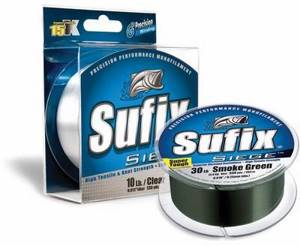
The reel contains 100–150 m, the minimum cost is 140 rubles, made in Japan. - Tiagra – high quality, good reliability, fluorocarbon – 100%, not visible in water, used for leashes.
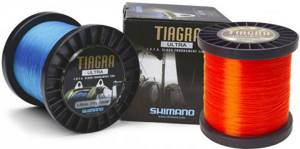
Price - from 160 rubles, country of origin - Japan. - Lon Power - abrasion resistant, blue, invisible to fish, used for delicate fishing, sports version, made in Japan, price from 250 rubles.
- Owner is a popular fluorescent gear, in demand, has good reviews, produced in the USA, price - from 300 rubles.
- Megastrong - manufacturer in China, has a fluorocarbon coating on nylon, accurate calibration, used for bottom fishing and spinning, price - from 400 rubles.
- Ades Daiwa - manufactured in Japan, high transparency, excellent wear resistance, quickly straightens, price - from 150 rubles.
- Shimano Antares Fluorocarbon - very soft tackle, sinks quickly, excellent wear resistance, contains only fluorine and carbon, real fluorocarbon fishing line, made in Japan, price - from 400 rubles.
Top 7 best fluorocarbon fishing lines with prices
Fluorocarbon gear differs in breaking load and diameter. These parameters influence the formation of the price, and the manufacturer of fluoronite is also very important. Here are the top 7 fluorocarbon products:
Sufix

Japan. The fishing line from this manufacturer is similar to nylon threads. A very high-quality polymer product that has all the necessary qualities. A spool (100-150 meters) of such thread costs about 140 rubles, there are also more expensive samples up to 900 rubles.
Tiagra

Japan. Fluorocarbon gear from this manufacturer is very reliable and high quality. The price varies from 160 rubles and above.
Ion power
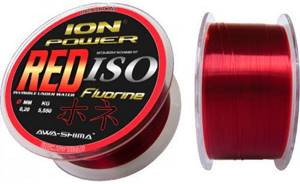
Japan. A sports version of fluronith. Almost invisible in water, resistant to external aggressive environments. Costs from 250 rubles approximately.
Owner
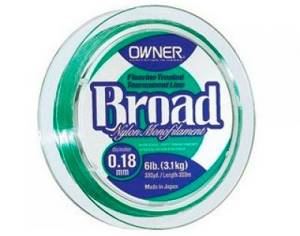
Production: USA. A very popular type of fluorescent gear, time-tested. The price is about 300 rubles depending on timber capacity and higher.
Megastrong
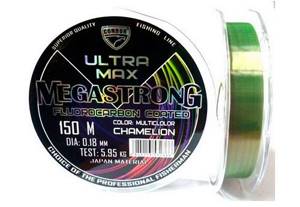
Chinese manufacturer. Not a bad piece of gear and, if used correctly, will last a long time. Prices are different and depend on the class to which fluorocarbon belongs: extra class - the price is about 400 rubles, economy class - lower in cost.
ADES Daiwa
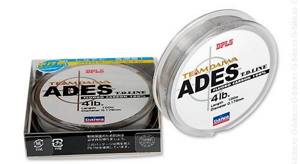
Japan. The price starts from 150 rubles. It has a high level of transparency, increased wear resistance, and virtually no tensile memory.
SHIMANO ANTARES FLUOROCARBON
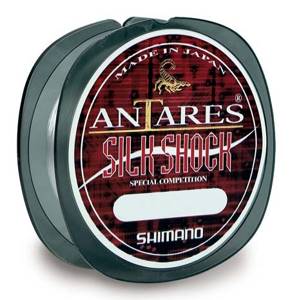
With this fluorocarbon tackle the bite will be a blast. It has all the qualities that real carbon should have. The price is about 400 rubles and more.
All prices are for fluorine gear, which is not fake and is made 100% of fluorine and carbon.
Reviews
Fishermen who have tried the best fluorocarbon fishing lines note the following points:
- The good thing about thread is that it has no memory. When unwinding from a reel, it does not form a ring and does not stretch out when landing fish.
- Using fluorocarbon fishing line as your main line is a waste of money. It is too expensive, it is advisable to use it for a leash.
- Good performance. The line is invisible to the fish, so there is always a good catch. The quality of fishing depends on the chosen location and gear;
- I like fluorocarbon line. Fishing is always successful, as the fishing line tends to camouflage itself.
- One way to tie a hook: pull the thread 10 cm into the eye of the hook. Make a loop from the end of the fishing line and wrap the remaining part around the shank of the hook. Thread the end into a loop. Moisten the fishing line with water and tighten the knot.
As a result, we can conclude: fluorocarbon fishing line, reviews of which are mostly positive, is valued among fishermen.
Which fishing line should I buy?
Every fisherman thinks about this question when preparing for the next fishing season. You need to decide what kind of fish and in what place you are going to catch. Particular attention should be paid to the stretchability, diameter and transparency of the tackle. The success of fishing depends on these indicators.
There is an opinion that the thinner the fluorocarbon line, the more invisible it is. This type of tackle is only suitable for sensitive fishing rods or spinning rods and very cautious fish, such as grayling.
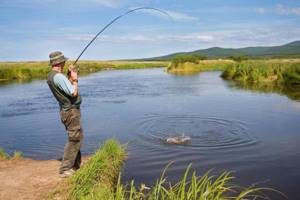
Thick threads are more suitable for spinning reels, where some effort is required when winding the line. When catching very large fish in a lake where there is great depth, the transparency of the fishing line fades into the background, the strength of the thread is important here.
In each specific case, the fisherman himself must determine the parameters of the fishing line based on his experience.
In Japan in the 90s, studies were conducted on how fluorocarbon line used for a leader affects the number of bites. They found that twice as many fish were caught when using this invisible thread.
